WORLD CLASS COACHING
Developing Soccer Intelligence Through 4v4 Vol 3
By Philip Cauchi
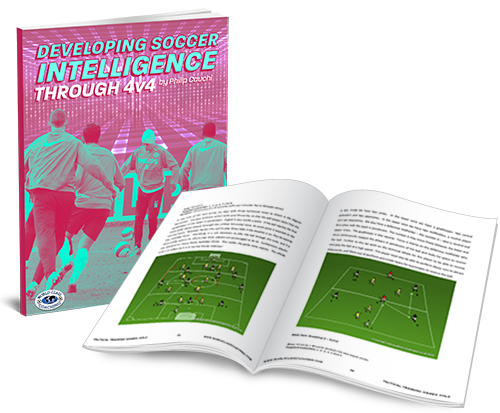
Table of Contents
PART FOUR
Progressive Sessions
Progressive Sessions
Session number: 21.
Moment of the game: In possession.
Team task: Build-up.
Aim: Build-up from the first stage to the creative stage.
Macro principle:
Establish options in the middle vertical channel to play in verticality.
Sub-principles:
1. Position of the goalkeeper to aid in retaining possession or switch the point of attack.
2. Central defenders 4 and 5 widen up.
3. Full backs 2 and 3 move higher up the pitch with the midfield line.
4. Low playmaker 6 creates a numerical superiority at the back to create more options for the build-up.
Sub-sub-principles:
1. Receiving stance.
2. Quality of passes – fast and along the ground.
3. Closest teammates to provide support around the ball – in front and/or behind the ball.
4. First option is to play deep, otherwise retain the ball and switch play if necessary.
Practice – 4v4+GKs and two neutral flank players.
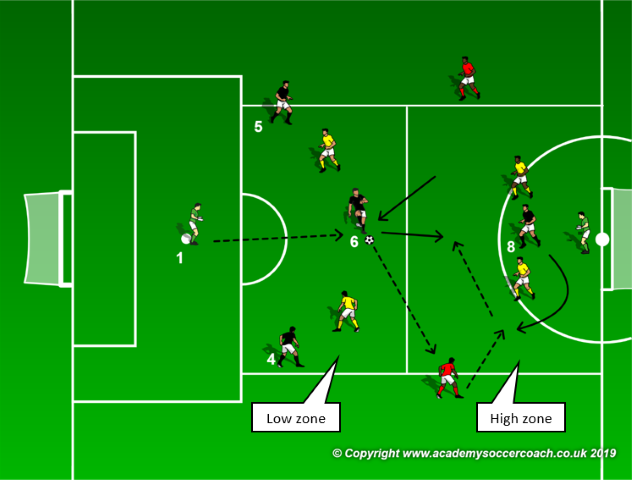
Area: 40 yards in length by 30 yards in width divided into two zones, the low one measuring 15 yards in length while the high one measures 25 yards in length.
Players: The attacking team has a goalkeeper in goal, two central defenders and two midfielders. The defending team has two strikers, two midfielders and a goalkeeper in goal. A neutral player plays on each flank giving the team in possession a numerical advantage.
Workload: 3 x 5 minutes with two minutes rest in between series.
Duration: 19 minutes.
Description: All players are restricted to remain inside their assigned zones except for the number 6 of the attacking team who can freely move between zones. The neutral flank players are not allowed to score.
Game – 4v4 plus goalkeepers.
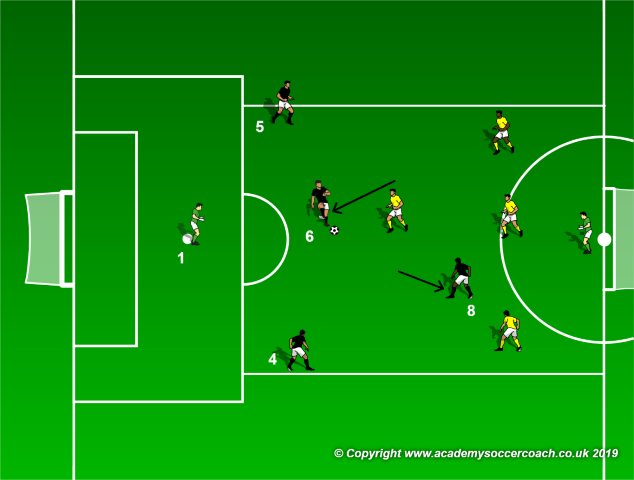
Area: 40 yards in length by 30 yards in width.
Players: The attacking team has a goalkeeper in goal, two central defenders and two midfielders. The defending team has two strikers, two midfielders and a goalkeeper in goal.
Workload: 3 x 5 minutes with two minutes rest in between series.
Duration: 19 minutes.
Description: Normal game with goalkeepers where the focus is on the attacking team (black) aiming to create the right opportunities to play forward. If the defending team win the ball, they counter on the opposite goal defended by the attacking team.
Progression: The attacking team may only score from a line marked twenty meters away from the defending team’s goal.
Session number: 22.
Moment of the game: In possession.
Team task: Build-up.
Aim: Create space and options to penetrate from central positions.
Macro principle:
Overload the middle area to create numerical superiority.
Sub-principles:
1. Striker 9 to provide length in the attack.
2. Lateral midfielders 7 and 11 to tuck inside and support the striker.
3. Midfielder 10 to provide cover and if necessary inserts himself into the attack.
Sub-sub-principles:
1. Counter movements to get free of marking to receive the ball in space.
2. Receiving stance.
3. Oriented first touch toward the direction of the next pass or move.
4. Timing of runs into the created space.
5. Timing and quality (weight and direction) of passes.
Practice – Four-player combination to finish on goal.
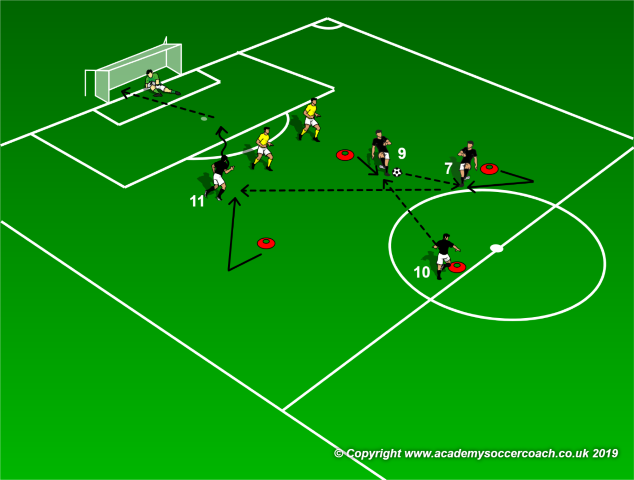
Area: Half of a regular sized pitch.
Players: Attacking players positioned in their respective positions in which they find themselves on the field of play. Therefore we have midfielder 10, lateral midfielders 7 and 11 and striker 9. We also have two defenders who become active after 10’s pass to 9 after the latter checks back to receive.
Duration: 10 minutes.
Description: The two defenders become active after 10’s pass to 9 and after the latter checks back to receive. Instruct both 7 and 11 to perform a counter movement as if to lose their marker before they receive the ball. After 9 receives the ball, it can be played back to 7 or to 10. From there the situation becomes free and the attackers have fifteen seconds to score.
Game – 4v4 to penetrate.
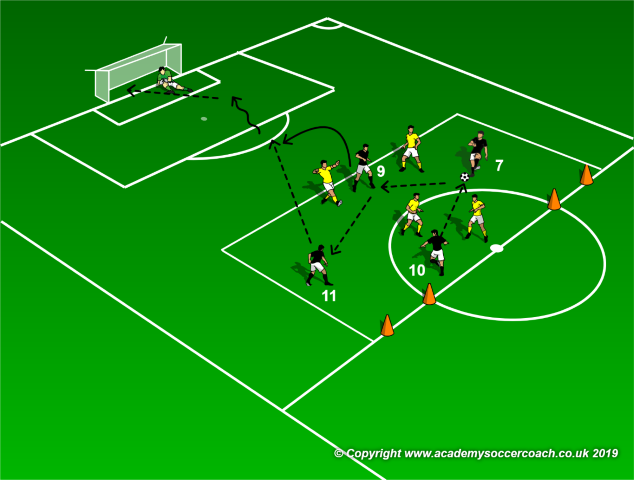
Area: Half pitch with a 30 yard by 40 yard area marked inside the pitch and adjacent to the centre line.
Players: Four attackers with reference to positions 7, 9, 10 and 11 and four defenders (two central defenders and two defensive midfielders) plus a goalkeeper in goal.
Workload: 3 x 5 minutes with two minutes rest in between series.
Duration: 19 minutes.
Description: The attacking team aims to play the ball behind the opposition’s defensive line and finish on goal against the goalkeeper. The attacker running in the space to receive the through ball plays 1v1 against the goalkeeper. If the defenders win the ball, they counter by guiding (passing or dribbling) the ball through the two mini goals marked with cones.
Progressions:
1. Move the marked inner area closer to the penalty area thus simulate playing against a low block. We can also narrow the width of the area to 20 or 25 yards.
2. As in one but a defender is allowed to contrast the attacker thus playing in a 1v1 situation.
3. Progress on (2) by having all the defenders tracking back when a through pass is played.
Session number: 23.
Moment of the game: Opponents in possession.
Team task: Deny the build-up.
Aim: Prevent the opponents from penetrating through the midfield.
Macro principle:
Compactness in the centre of the pitch.
Sub-principles:
1. Compact midfield sector.
2. Zonal marking.
3. Cut off forward passing lanes.
4. Force play towards the outside.
Sub-sub-principles:
1. Establish pressure on the ball.
2. Mark potential receivers.
3. Distance and angles of coverage.
4. Marking stance and positioning.
Practice – Prevent penetration.
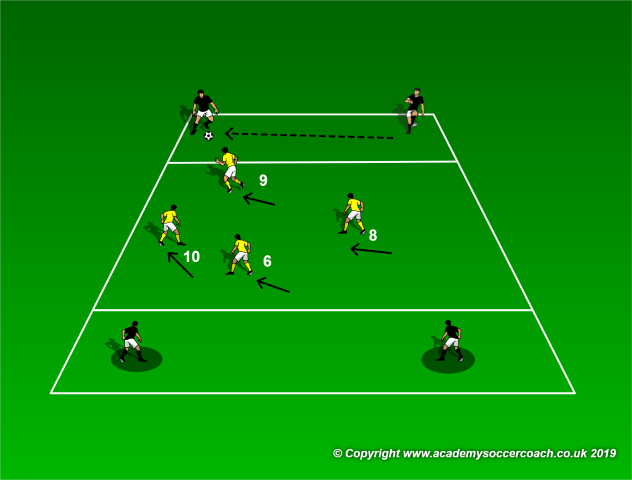
Area: 30 yards in length by 20 yards in width.
Players: Four attackers – two on both sides and four defenders set in a block in the centre of the area.
Duration: 10 minutes.
Description: The four defenders work in unison to prevent the attackers from playing a split pass and reach the target players on the opposite side. All players are restricted to remain inside their assigned zones. In case where the ball is played over the defenders’ heads, they may track back into the target attackers’ zone. If the defenders win the ball they aim to score by dribbling over the line guarded by two of the attacking team’s players from where the ball was passed while the opposite two attackers track to defend with the aim of regaining possession of the ball.
Progression: Increase the width of the zone to 25 yards thus making it harder for the defenders to cover and intercept passes.
Game – 4v4 without goalkeepers.
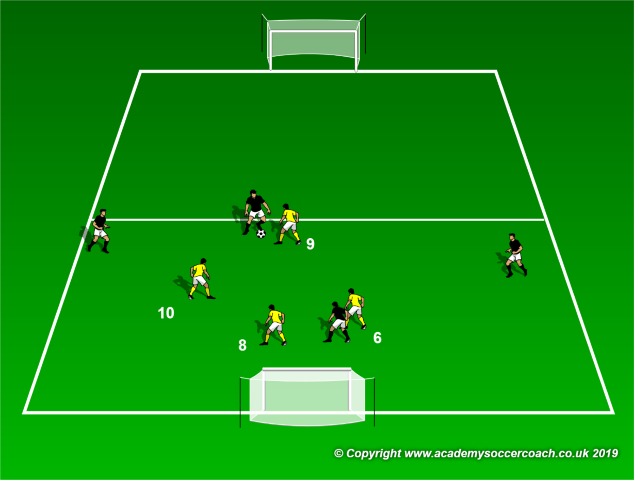
Area: 30 yards in length by 25 yards in width which is divided into two equal horizontal halves and where a regular goalpost is positioned at each end.
Players: Both teams are composed of four players.
Workload: 3 x 5 minutes with two minutes rest in between series.
Duration: 19 minutes.
Description: Both teams must score into the empty goal from inside their attacking half. This forces the defending team to retain compactness, close the gaps for the attacking team to play forward (or shoot), make play predictable towards the flank where there is less space to manoeuvre and prevent the opponent from getting out of the press. No corner kicks or throw-ins exist. Any restarts take place by the team in possession from their goal line.
Progression: The middle line is removed. Goals may be scored from anywhere on the pitch. The defending team is forced to keep an eye for any balls played overhead from inside the attacking team’s half.
Reflection
The aim of this book is not for the individual coach to just enjoy the presented exercises but to stimulate the coach to think that the chosen training activities must come from the match itself. Every minute spent at the training ground should be aimed to develop the team’s physical, technical, tactical and mental domains in a holistic manner. These domains should as much as possible be included in all the exercises delivered in the session. Soccer is a game where these domains are continuously integrated with each other. A negative perception of a stimulus (mental) will affect the decision taken in a situation (tactical) with a negative influence on the execution of a soccer action (technique).
The conditioning aspect of the game cannot only be done in isolation. Although we may utilise some form of analytical exercises to develop soccer fitness, the most effective and efficient way to acquire this is by playing variations of the global game such as the 4v4. Integrated training approaches aid in the development of both the technical and physical domains. In soccer, however, the ability to keep perceiving the right stimuli and making the correct decisions during the whole ninety minutes is of paramount importance. Players should thus be trained to continue making decisions under conditions of fatigue, while also in the long term aiming to delay the onset of fatigue accumulation.
This book is about the various uses of the 4v4 from developing young players to training highly skilled professionals in the sport. A copy and paste of the presented exercises is not recommended. A coach may take ideas but has to implement them according to the level and needs of the players. If you have noticed, the recommended age bracket for the training sessions and practices in this book does not exist. The simple reason being that age is not an ideal indicator for training. Ability and readiness to learn and acquire new skills are however!
I wish you will find this book fruitful in your daily work as coaches. Let us continue to evolve together – in whichever corner of the world we come from – to develop the sport of soccer!
Sincerely yours,
Philip Joe Cauchi
References
Aznar, D., Juanes, R., Dorado, M. and Gaspar F. (2014). Advanced Spanish academy coaching. London: Soccer tutor.
Bordonau, J.L. & Villanueva, J. (2018). Tactical periodization – a proven successful training model. London: Soccer tutor.
Ford, P. (2016). Skill acquisition and learning through practice and other activities. In T. Strudwick (Ed.) Soccer science. Leeds: Human kinetics.
Grima, S. (2016). Foundations for a football culture (2nd ed.). Malta.
Grima, S. (2017). Effective football coaching. Malta.
Mariman, H., Berger, H. and Coolen, L. (2015). Dutch academy football coaching U12-U13. London: Soccer Tutor.
Jankowski, T. (2016). Coaching soccer like Guardiola and Mourinho. Maidenhead: Meyer & Meyer Sport.
Jozak, R. and Kepčija, I. (2018). Croatian football federation development curriculum. Zagreb: Vivid & Schine j.d.o.o.
Verheijen, R. (2014). Football periodisation. Amsterdam: World Football Academy.


